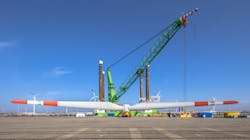Commentary: Holistic approach to floating wind maintenance can reap opex rewards
Evgenia Golysheva * ONYX Insight
Floating offshore wind (FOW) continues to be a growing player in the energy mix alongside fixed-bottom offshore turbines. By mid-century, the contribution of FOW is expected to represent 15% of the offshore wind share, with a total installed capacity of about 300 GW, requiring around 20,000 turbines.
While demand for renewable energy accelerates to support global net zero goals, FOW presents significant opportunities for developers to venture into deeper waters, specifically at depths greater than 60m, which are deemed unsuitable or uneconomical for fixed-bottom turbines.
As operators venture further from the shore, winds are generally stronger and more consistent compared to in-land, allowing for increased productivity. They also have reduced environmental impact associated with seabed disturbance and are likely to receive less objection from local communities.
However, as the number of FOW farms increase, understanding the unique challenges they present is crucial to the long-term productivity and success of current and future projects. This is particularly true with regards to the approach of operations and maintenance (O&M).
While the benefits of FOW for the regions with deep waters or complex seabed are evident, the use of floating turbines also introduces added intricacies. The technology requires different infrastructure, and not many ports are currently capable of accommodating floating technology. Logistics become more complicated as projects move further from land and operators must contend with installations in previously inaccessible areas with increased sea depth, wave height and windspeed.
The variety of design concepts is also difficult to navigate and to some extent, slows down the cost reduction which is much needed. The industry needs to get behind a few design ideas and invest in scaling up to support both manufacturing and robust O&M strategies.
The remote location of offshore wind farms also presents greater intricacies in O&M with regular inspections more challenging due to difficulty in deploying technicians to carry out on-site inspections. This issue is only amplified when relating to unplanned maintenance or malfunctions which inevitably result in downtime, and additional project costs.
Currently, there is also still no consensus on the best approach to component replacement. Methods such as coupling cranes and tow-to-shore are viable, however they carry high costs which are not sustainable long-term.
Additionally, there is an argument that FOW might bring an additional unwelcome complexity and uncertainty to the offshore sector at a time when developers and investors are already nervous following cancelation of several large projects due to inflation and supply chain pressures.
Utilizing digital technologies will not solve all of these challenges, but it can provide more certainty both in the design and operational stage of the project lifecycle. Condition monitoring systems can be a game-changer for operators seeking methods to monitor floating offshore assets effectively and efficiently. While the technology is already established across instrumentation such as gearboxes and drivetrains, new innovations are now allowing the same level of advanced diagnostics on rotor, structural elements and the floater itself. By utilizing advanced sensing and remote visual inspection, operators can for the first time gain a clear picture of overall turbine health, detect issues before they become substantial, and ultimately reduce the number of turbine visits.
The benefits this technology can deliver for FOW as well as the overall offshore sector should not be underestimated. Tailored selection of such technologies that provide the greatest coverage depending on turbine type, floater selection etc., will not only significantly reduce technology risk during operation, but also help investment decisions and improve opex forecasts.
Such advanced diagnostics can support full predictive maintenance (Pdm) strategies which ultimately allow operators to better forward plan, therefore creating a proactive approach to O&M. For example, the lead time on drivetrain defects detections is 6-18 months. If issues with these components are detected in advance, this allows sufficient time to plan ahead and minimize the number of interventions.
As the FOW market grows and the number of turbine concepts increases, it is essential condition monitoring strategies are designed alongside O&M strategies early in the project design stage to ensure the benefits of this technology are fully realized. However, for this to take place, greater collaboration between FOW design teams and O&M providers is critical. While there has been positive progression in this area, the process must be greater streamlined for the sector to become more standardized.
A holistic approach to turbine PdM is something that all operators should be moving towards, whether they are using onshore, offshore fixed or floating facilities. With increasing turbine scale and complexity, the use of analytics and data in O&M management strategies becomes an ever-more compelling solution.
The author
Evgenia Golysheva is VP Strategy and Marketing, ONYX Insight.
